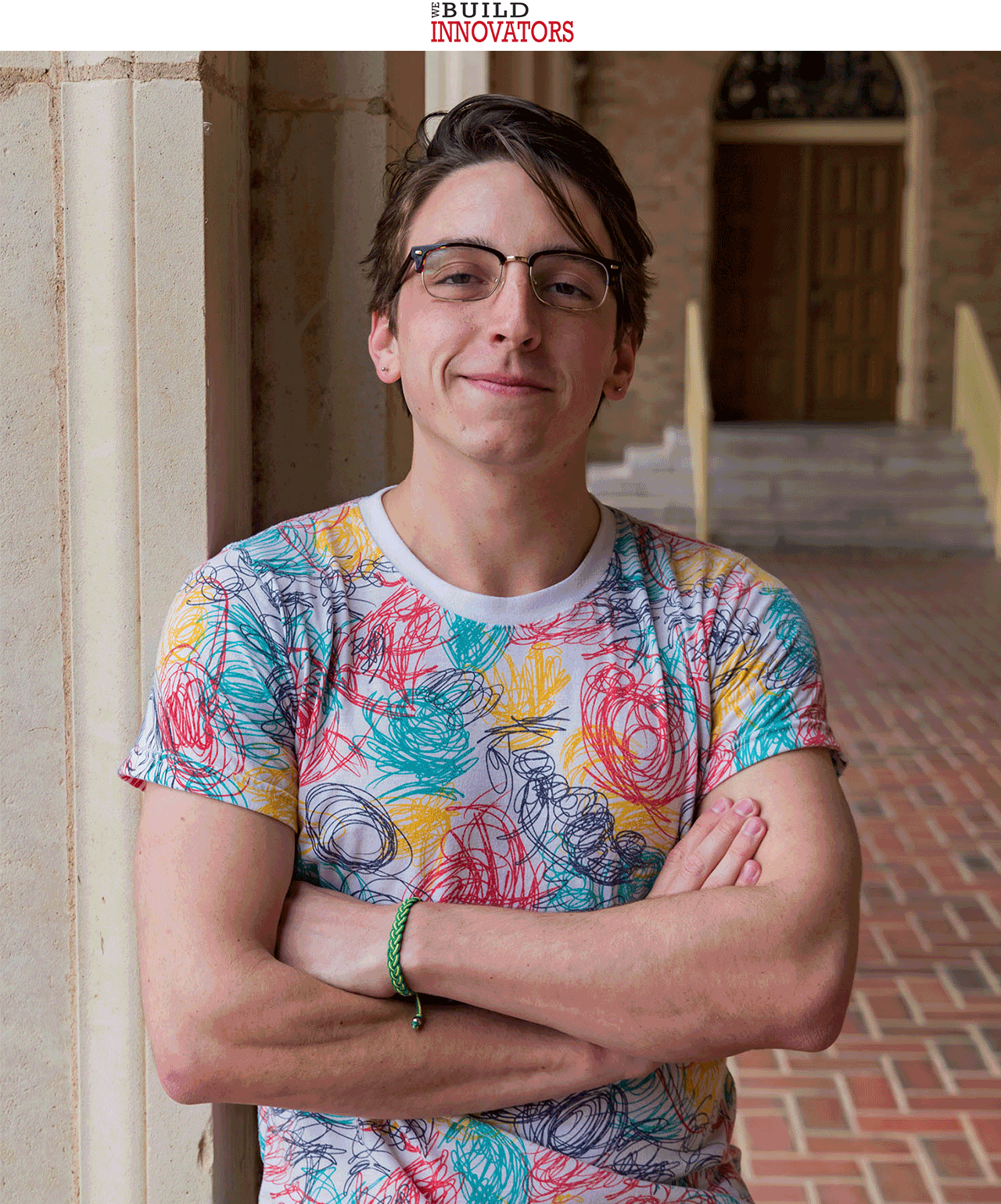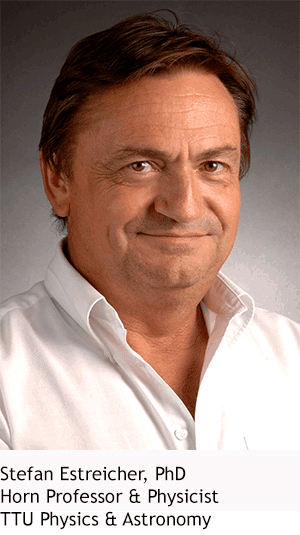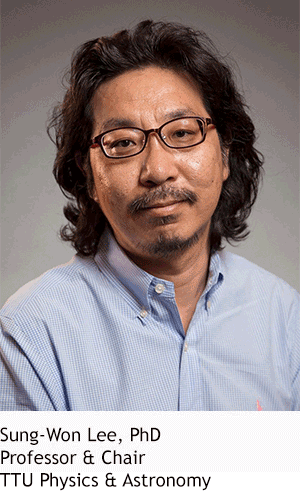Leading the Way

Texas Tech University physics senior Trey Vincent is first author on research chosen as Editor's Pick and published in the peer-reviewed Journal of Applied Physics.
Physics Senior Trey Vincent Helps Identify a Curious Defect in Silicon
Vincent and TTU Physicist Stefan Estreicher Are Studying Copper-Related Defects in Semiconductor Silicon.
4.16.2020 by Glenys Young
A troublesome problem in silicon-based electronics is one step nearer to a solution, thanks to the work of a Texas Tech University physics professor and his undergraduate research assistant.
Silicon chips are the primary components of most computing devices. But unwanted transition-metal impurities, which are almost always present, can degrade the devices' performance. Fifty years ago, scientists first observed a copper-related defect with characteristic electrical and optical signatures. It was first assigned to two copper atoms and became known as the "copper pair defect." Later experiments showed that at least four copper atoms were involved. Since isolated copper diffuses as a positively charged copper ion, explaining the formation of this defect became a challenge.
Senior physics major Trey Vincent and his research mentor, Horn Professor Stefan Estreicher, have been working to solve this mystery by determining the configurations, electrical and optical properties and formation pathway of successive copper aggregates —that is, the step-by-step process by which copper moves through silicon. The sequence of events they predicted theoretically was confirmed by experimental work done by collaborators in Germany and Russia. Their results recently were published as an Editor's Pick article in the peer-reviewed Journal of Applied Physics.
 "When producing silicon chips, it is important to know what materials you are working
with and the properties of those materials," said Vincent, lead author on the study.
"Because it is inevitable that copper will move into the silicon, the study of copper
defects is imperative."
"When producing silicon chips, it is important to know what materials you are working
with and the properties of those materials," said Vincent, lead author on the study.
"Because it is inevitable that copper will move into the silicon, the study of copper
defects is imperative."
The goal, Estreicher said, is to understand how impurities and defects can affect the electrical, optical and thermal properties of semiconductor materials.
"Copper is a very good metal for contacts on electronic circuits, but it penetrates into the silicon crystal and forms unwanted, electrically active precipitates, even in otherwise defect-free silicon," Estreicher said. "Since copper diffuses as a positively charged species, copper ions should repel each other. The mechanism involved in the formation of copper precipitates was not understood for a long time. This paper is a substantial step forward in understanding what is going on."
Vincent and Estreicher suggested a series of intermediate steps that occur as, and in order for, copper to permeate through silicon.
While Estreicher emphasizes that their work is theoretical, there also was an experimental aspect to the research. Vincent and Estreicher did much of their theoretical work using Texas Tech's High Performance Computing Center and the Texas Advanced Computer Center at the University of Texas. From there, their co-authors at the Institute for Applied Physics in Germany and the Institute of Microelectronics Technology and High Purity Materials in Russia, part of the Russian Academy of Sciences, tested the theory.
The results matched closely.
"This is the first step," Estreicher said. "Applying this knowledge to devices requires another type of expertise, not theory. Here, we combine first-principles theory with high-level electrical and optical measurements to identify a dynamic sequence of events as copper atoms precipitate, one after the other. Several intermediate, small precipitates are identified theoretically and characterized experimentally. It's a nice match, especially since the theoretical predictions were made before the experimental identification."
 Sung-Won Lee, professor and chair of the Department of Physics & Astronomy, said the publication speaks to both Vincent's aptitude as a young researcher and
the quality of research opportunities available for students at Texas Tech.
Sung-Won Lee, professor and chair of the Department of Physics & Astronomy, said the publication speaks to both Vincent's aptitude as a young researcher and
the quality of research opportunities available for students at Texas Tech.
"The fact that Trey was the first author of this scientific paper and that it was chosen as the Editor's Pick is an outstanding academic achievement for an undergraduate student," Lee said. "I firmly believe Trey will play a major role in the field of theoretical condensed-matter physics in the future. I am very proud of him and can say Trey's academic success is a great milestone for many undergraduates and the faculty members who guide them."
Other Benefits
Hoping to solve such an important issue has required plenty of effort on the researchers' part. Estreicher published his first paper about copper interactions in silicon in 2002 and on this particular problem in 2011. Vincent got involved in 2018, after taking Estreicher's class as a freshman and asking to join the professor's research.
"Working with Dr. Estreicher has by far been the most valuable part of my entire college experience," Vincent said. "If you are willing to work and find a faculty member you get along with, they will be willing to help you greatly. Even if you have no plans of working on research as a career, it is incredibly helpful with intellectual development."
As Vincent prepares to enter graduate school, having this publication under his belt may give him a leg up on his peers.
"This paper is his first contribution as the leading author, but he is co-author on two previously published papers," Estreicher said. "This level of publication is unusual for an undergraduate student. When an undergraduate student accumulates publications, it shows his or her quality as a researcher and impresses whoever reads the resume much more than high grade point averages."
That's just one reason Estreicher believes all students should develop an interest in research and scholarly activity, especially undergraduates.
"What you learn in class is material that is already known," he said. "Research involves new issues, material that is still unknown. Many faculty members at Texas Tech would encourage curious undergraduate students to participate in research activities in their group. But students need to make the first step, and success is not guaranteed. Research involves a lot of work, and sometimes frustrations: one must be patient and hang on—especially when things don't work out the way we wish they did."
College of Arts & Sciences
-
Address
Texas Tech University, Box 41034, Lubbock, TX 79409-1034 -
Phone
806.742.3831 -
Email
arts-and-sciences@ttu.edu
